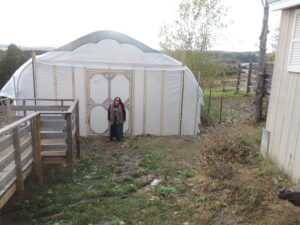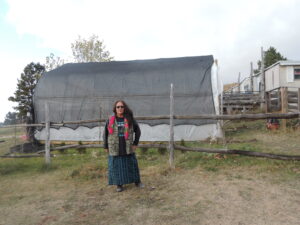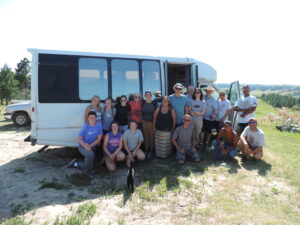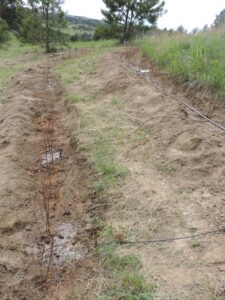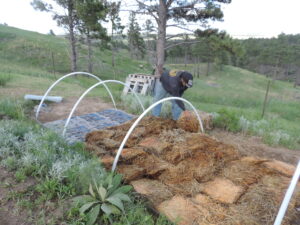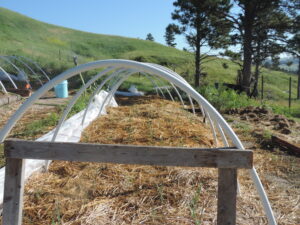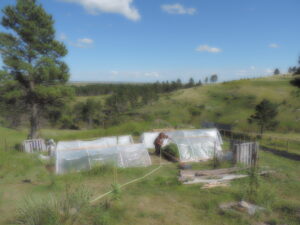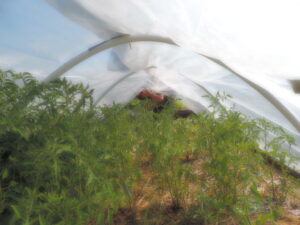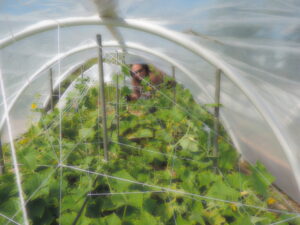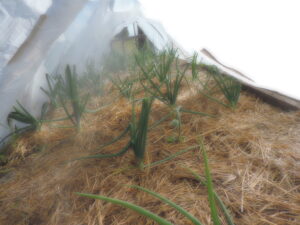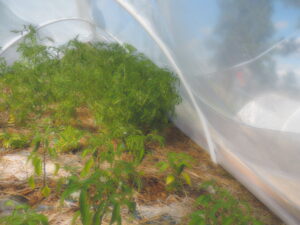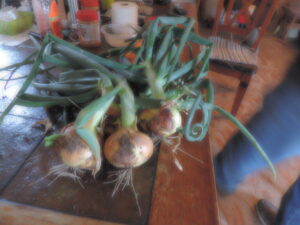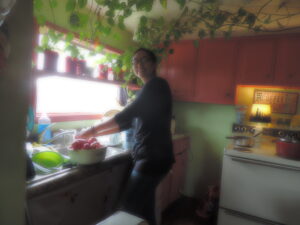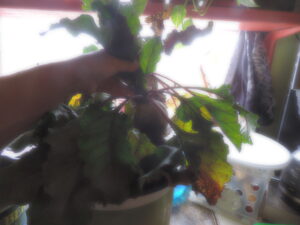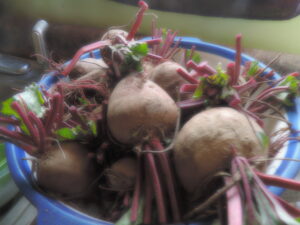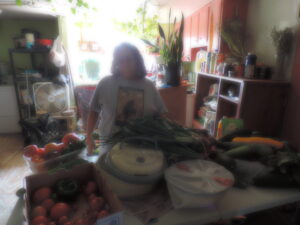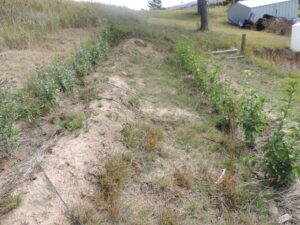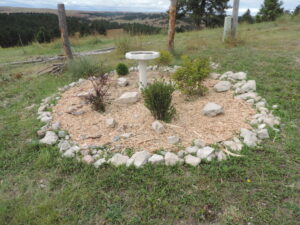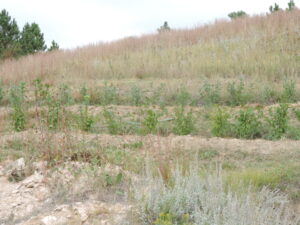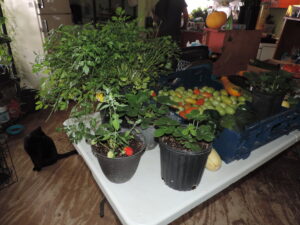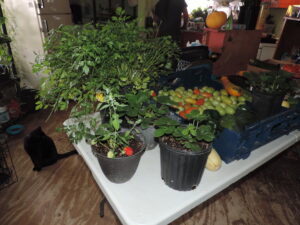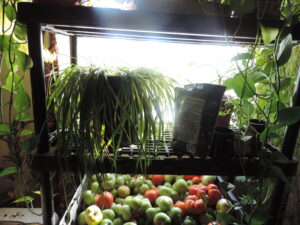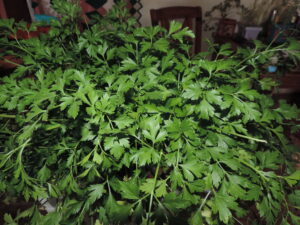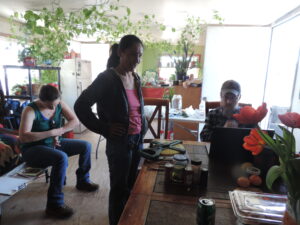Final report for FNC19-1197
Project Information
My family has been planting food for about 12 years on about 2 1/2 acres of land. Although we own 165 acres of land, most of it is hilly, forestry, rocky land. It is windy here most of the time and that affects the crops we plant. It usually rains and hails here and for three years we lost most of our crops as a result. I planted squash, beans, corn, beets, lettuce, tomatoes, jalapenos, onions, cilantro, melons, etc. Some years we yielded a good outcome, others hardly nothing. I became a certified USDA farmer about three years ago, after researching other ways to grow, I finally decided to apply permaculture and agro-forestry principles. I am currently growing in three low tunnels and I am in the process of constructing a 20 by 24 ft. Gothic high tunnel to grow later in the season, we have also planted many trees for wind break and 8 different kinds of fruit trees on terraces along side our biggest hill, we have plans for planting other Indigenous plants.
Growing food on Wiconi Waste’s Resistance Farm has always been a big challenge. Our 165 acres are all hills and our primary site is located on top of a high hill, west of Porcupine SD, approximately 3,400 ft above sea level. It gets very windy up here and we also get lots of hail, snow, and freezing temperatures. Heavy downpours can cause soil erosion. Our people don’t have a lot of money and many families around Porcupine have land that is sloped and forested. We propose to build a regenerative agroforestry permaculture demonstration farm where other Lakota people can learn all about permaculture, agroforestry techniques, soil conservation in erosion prone areas, how to grow on a slope, drip-irrigation, as well as how to use composting and mulching to improve the quality of our local soils. We also propose to create a local heirloom, organic seed bank on our farm to make it truly sustainable for generations to come. We will be working with SDSU Extension’s Tribal Local Foods and AgrAbility program who will be providing workshops and hands-on demonstrations of the above techniques, alongside us.
1. Identify techniques and strategies to reduce erosion on sloped, forested landscapes.
2. Identify cultivatable traditional Lakota plant foods that can be incorporated into a regenerative, agro-forestry permaculture farm.
3. Evaluate the effectiveness of permaculture agroforestry techniques and strategies on forested, slopes.
4. Evaluate the effectiveness of using a system of drip-irrigation, sheet mulching and contoured plant beds and pathways on forested slopes to improve the quality of our soil.
5. Share findings through videos, pictures and printed information on project with community as well as on social media and through workshops in partnership with SDSU Tribal Local Foods/AgrAbility program.
Research
Collaboration on proposed project will be with SDSU Extension Tribal Local Foods and AgrAbility extension educators, USDA-NRCS Tribal Liaison’s office, the local non-profit, Re-Member, contractor and extended family members as well as with the Central Incubator-Hub site that SDSU and Re-Member put into place this year just a few miles east of Porcupine that works with landless tribal new farmers and with those farmers who either don’t have easy, un-encumbered access to their lands or don’t yet know how to produce foods on their lands. SDSU Extension’s Tribal Local Foods program teaches sustainable, small-acreage production strategies to new tribal farmers. We will be a demonstration site for their participants to come and see agroforestry, permaculture and conservation practices for hilly and forested landscapes. SDSU Extension will host a series of workshops on permaculture, agroforestry, soil type and erosion factors, site design and planning, rain catchment. These workshops will be hands-on, experiential with print outs and fact sheets developed by SDSU Extension. They will use Pre/Post-tests to show change in knowledge and awareness. We will also make use of You-Tube videos on permaculture, agro-forestry and other topics from reputable sources, such as Extension, Universities and recognized NGOs.
There will be lots of hands-on planting and harvesting of vegetables, fruit trees, shrubs, berries and native plant foods. Participants and community volunteers will help install a permaculture, sheet mulching and irrigation system. We will also use permaculture strategies and techniques such as swales, key-hole beds and raised beds to reduce erosion, move soil moisture to where we want it to go instead of it just washing away our soils during heavy rains and snow melt.
My soil was tested previously so I used that report on my soil, and a sheet mulching system was used when we planted our crops this year (2019), because we live on a rocky forestry hillside, and low tunnels were used to cover them to protect the crops from wind and hail. We didn't have any damage to crops because of the covers, mulch was good for all the crops -- it helped them grow fast and retained water better. First year we didn't lose any crops. This year I will test the soil and use a rain gauge and record amounts at the beginning, middle and end of summer. The raised beds make it so much easier to keep weeds out. I had a lot of help both volunteer and paid so it was good training for all of us involved in planting our trees and shrubs.
Educational & Outreach Activities
Participation Summary:
March 1st 2019 I met with the SDSU extension workers for our first initial meeting about the landscape, gardens, planting, etc.. We communicated through text and e-mail. Spring was very cold as we endured the bomb cyclone that flooded South Dakota and Nebraska. The preparation for our gardens lasted until June 6, 2019 when my husband and I met with SDSU workers, volunteers from Remember Organization, and family members who are members of Wiconi Waste Resistance Farm. I did a presentation to participants about Wiconi Waste Resistance Farm/agroforestry and permaculture Farm and took them on a tour of our land and farm. Approximately 30 people attended our presentation and volunteered to help us build our gardens, plant trees and shrubs. Throughout the summer we had family members help with our garden and also a few paid workers. Throughout the summer we had visitors. On July 30th we had another presentation and tour of our farm. I was interviewed by PBS about our farm and they filmed our land and hope I'll be included in the film they were making. We also had a sign-in sheet for each presentation. Other presentations will follow throughout the year.
2020 was a challenging year. We lost many elders and tribal members to COVID-19 and travel was put on hold. We also have not heard from any of our SDSU Extension collaborators since our initial meeting in 2019. Our outreach activities are put on hold for the year and we received a grant extension.
Learning Outcomes
I have acquired new skills from experimenting with permaculture and agroforestry. This year 2019 we started planting in our same soil except we used a sheet mulching system, the soil was tested in two of our gardens and the soil is moderately low in nitrogen, the phosphorus level is low also, potassium level is high, soluble salts are low too but that is a good thing, the organic matter is medium so it will be beneficial to till and add our organic matter, which is mulch, the ph is moderately alkaline and it will take us the entire 2 1/2 years to completely add mulch everywhere because my farm land is so big, but planting with mulch was an effective system for 90% of the food we planted this year. I yielded almost 100% of my crops due to the permaculture principles we applied. Hardly any weeds to pick when you plant with mulch, the water holding capacity is better because I didn't have to water as much either. The plants were covered and protected from the rain and high winds so nothing was ruined this year. We built terraces instead of swales because we found that our hills are very steep and terraces worked better. We planted over two hundred trees, including fruit trees and shrubs on our hillsides. We are overcoming the barriers which were soil erosion with no water holding capacity, but we found that mulch helps to hold water better. The disadvantage at our farm is still the wind; we had to rebuild our low tunnels. The advantages of getting a grant like ours is we come from the poorest county in the United States and without it we could not afford to improve our farm and our land, it feeds my family and frees up some of our income so we can buy other needed things. I would recommend permaculture and agroforestry principles to every farmer.
2021 Updates to timeline, project progress:
Much of 2020 project work was delayed, due to COVID-19 and we focused on maintaining existing plantings. Many of the earlier plantings struggled to survive due to high winds and drought. We are planning on doing another fall planting in 2021 and mulching in plants heavily. We are also exploring planting more traditional medicinal plants to grow in our tunnels like Osha Root and are trying to source seed and are looking to establish hedgerows to protect fruit trees against the winds.
Project Outcomes
"I am very thankful for Wiconi Waste Farm its a living model for us to learn from...you are what you eat and health is wealth. Healthy organic soil makes beautiful nutrient rich fruits and veggies and we could eat and feed our relatives medicine." First year family Farmer, Porcupine South Dakota 57772.
